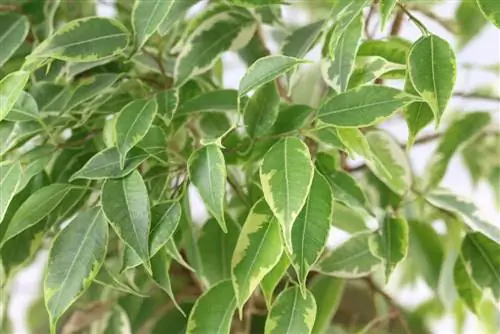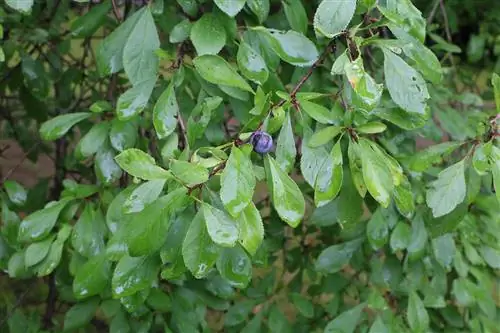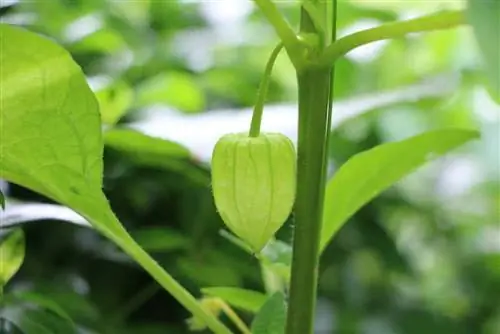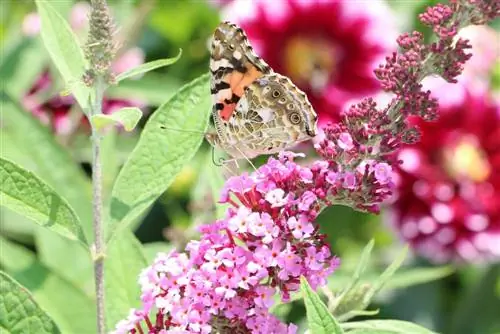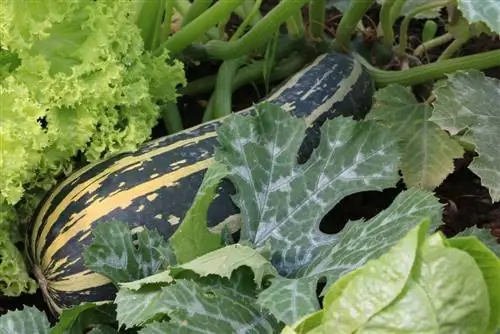- Author admin [email protected].
- Public 2023-12-17 03:39.
- Last modified 2025-06-01 06:48.
The strong pruning tolerance of a Ficus Benjamini allows, strictly speaking, pruning at any time. If you notice individual, disturbing branches, you can cut them off immediately.
When is the best time?
If you subject the birch fig to extensive topiary or want to cut back the ornamental tree completely, this measure should be done in winter. You will achieve the best success when fresh shoots are about to appear in the transition from late winter to spring. Of course, annual pruning is not a must for your birch fig. In contrast to other shrubs and trees, the scissors on the Ficus Benjamini are used when necessary and not at fixed time intervals.
Important preparation work - be careful with the plant sap
Birch figs are permeated with a poisonous milky sap. If it comes into contact with the skin, the sticky secretion can trigger rashes, eczema and other allergic reactions, including anaphylactic shock. If the plant sap drips onto your valuable parquet, laminate or carpet floor, the stains are very difficult to remove. The larger the cuts, the more toxic sap comes out. Please pay particular attention to the following preparatory work:
- When cutting in winter, cover the ground with tarpaulins, old newspapers or old curtains
- When cutting in spring or summer, cut the birch fig outside on soil or grass
- Sharpen the blades of the scissors and disinfect them with alcohol
- Put on gloves and long-sleeved clothing
To stop the flow of juice quickly, provide small pieces of absorbent fleece or torn Tempo tissues. If you press a piece of fleece onto the wound after each cut, the milky sap cannot drip onto the leaves or the ground.
Note:
Did you know that sticky leaves on a birch fig are not necessarily due to the poisonous plant sap. If the damage occurs within days or even weeks of the last cutting date, it may be an infestation by aphids. The sucking pests excrete sticky honeydew as a waste product, which sticks together the pretty leaves.
Instructions for shape and maintenance pruning
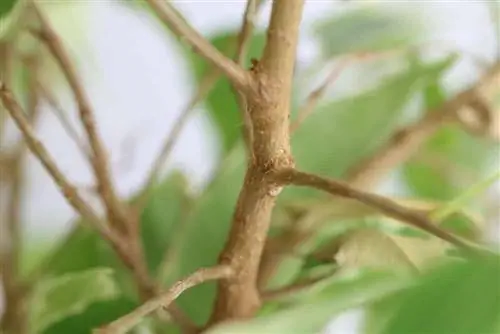
If you have ordered your Ficus Benjamini to be pruned, the first steps on the agenda are the preparations recommended here. The actual cut does not pose any gardening stumbling blocks, as you can cut back into the old wood yourself and the plants will still sprout happily. To ensure that the birch fig then sprouts beautifully bushy and compact, the following pruning is advisable:
- At the beginning, cut off all dead shoots at the base
- Remove cross-growing branches that are directed towards the inside of the bush or crown
- Remove older or weaker branches from branches that are too close together
- Short any branches that stick out of the shape
- Cover every cut immediately with a piece of fleece
Place the scissors so that there is 3 to 5 mm below one of the alternate leaves or a node. The shorter the distance between the interface and the leaf or node, the more vital the fresh shoots will be. If there is doubt about whether a shoot has died or not, carry out a vitality test. Scrape some of the bark off the branch. If you see brownish-dry tissue underneath, cut off the shoot completely. A fresh green color, on the other hand, indicates that you can hope for new leaf growth on this branch.
Tip:
Your Ficus Benjamini will wear its most beautiful leaves when it is allowed to stay on the balcony from June to September. As long as the nighttime temperatures do not fall below 16 degrees Celsius, the tropical ornamental tree feels at home in a partially shaded location.
Cutting back Ficus Benjamini radically - instructions for the rejuvenation cut
Various causes may make it necessary to radically cut back a Ficus Benjamini. In the majority of cases, the tropical wood exceeds its spatial dimensions or is bare and senescent as a result of neglected care. Now you benefit from the good-natured pruning tolerance. The best time for rejuvenation pruning is in winter because the stress is lowest when the sap is dormant. This is how the rejuvenation cut works:
- Cut off dead shoots completely and without stumps
- Cut off all dry branches that are too close together and cross-growing ones
- Short remaining branches by half to two thirds
Then repot your Ficus Benjamini in fresh substrate to mobilize its floral powers. This opportunity gives you a clear view of the roots when the plant is potted out. Remove the old substrate and examine the bale carefully. You should cut off any stunted, rotten-brown or dried roots.
Train Ficus Benjamini to a standard tree
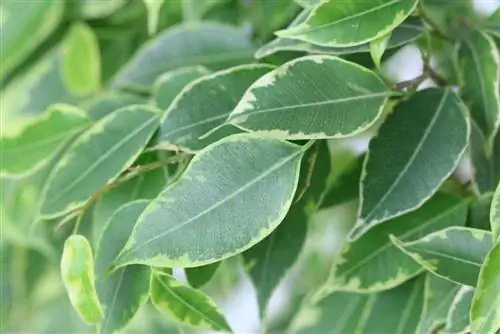
With a bushy, round crown on a slender trunk, a Ficus Benjamini creates a pleasant ambience in living and working spaces. Since training the evergreen tropical beauty is time-consuming, the purchase costs considerable money. Recreational gardeners put their money where their mouth is and train a young birch fig to become a standard tree on their own. Follow these steps:
Starting phase
- Select the best central shoot on a he althy, strong young plant
- Place a wooden stick in the ground next to the central shoot
- Connect rod and shoot together with hose ties or rings
- Alternatively, tie several ground shoots together to form a trunk
Construction phase
- Cut off all competing shoots of the trunk shoot at the base
- Cut or tear off side branches on the future trunk
- Successively guide the central shoot upwards on the support rod
Crown Education
- Only cut off the shoot tip when the desired trunk height has been reached
- Make the cut 3 to 4 leaves above the desired crown height
- Short side branches of the crown by a third to promote branching
- Side branches below the crown are radically cut down to the trunk without stubs
To ensure a shapely crown forms over time, regularly remove any stunted branches that are growing in the wrong direction. Please make sure to remove dead wood regularly so that the crown is always flooded with light. Ideally, the branches are arranged like a perfectly tied bouquet of flowers.
As the crown training progresses, it results in a shape and maintenance pruning according to these instructions. Thin out dead wood every late winter. You decide individually to what extent individual or all branches should be cut back after a thinning cut. Take a few steps back and examine the shape of the crown.
Tip:
If a birch fig sheds its beautiful leaves, this is no reason for pruning. The exotic green plant reacts to unsuitable conditions by falling leaves.
The most common causes are an abrupt change of location, drafts and cold roots. Once the problems have been resolved, fresh greenery will sprout on the bare branches within a short time.
Cutting the birch fig as a bonsai
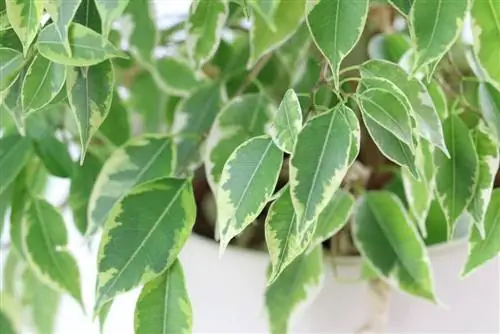
When it comes to professional pruning of Ficus Benjamini as a bonsai, different standards apply in terms of frequency and pruning. In order to wrest the characteristic mini format from the strong-growing tropical tree, you cannot do without just one pruning per year. The following short guide summarizes the correct procedure:
- Cut at 6 week intervals from April to September
- Cut new branches with 5 to 7 leaves back to 2 to 3 leaves
- Cut off individual shoots that protrude from the crown shape
- Clear out dead wood in spring and again in autumn
- In connection with each repotting, shorten the roots by a third
- Dab bleeding cuts with kitchen fleece or dust with charcoal ash
Authentic design aims to ensure that in the end there is no thick branch on top of a thin branch. Give your bonsai enough time between pruning appointments for regeneration and further growth. The masters of Asian bonsai art do not constantly attack the green works of art with scissors, but also leave the mini ficus undisturbed for a long time and enjoy its charismatic appearance.

